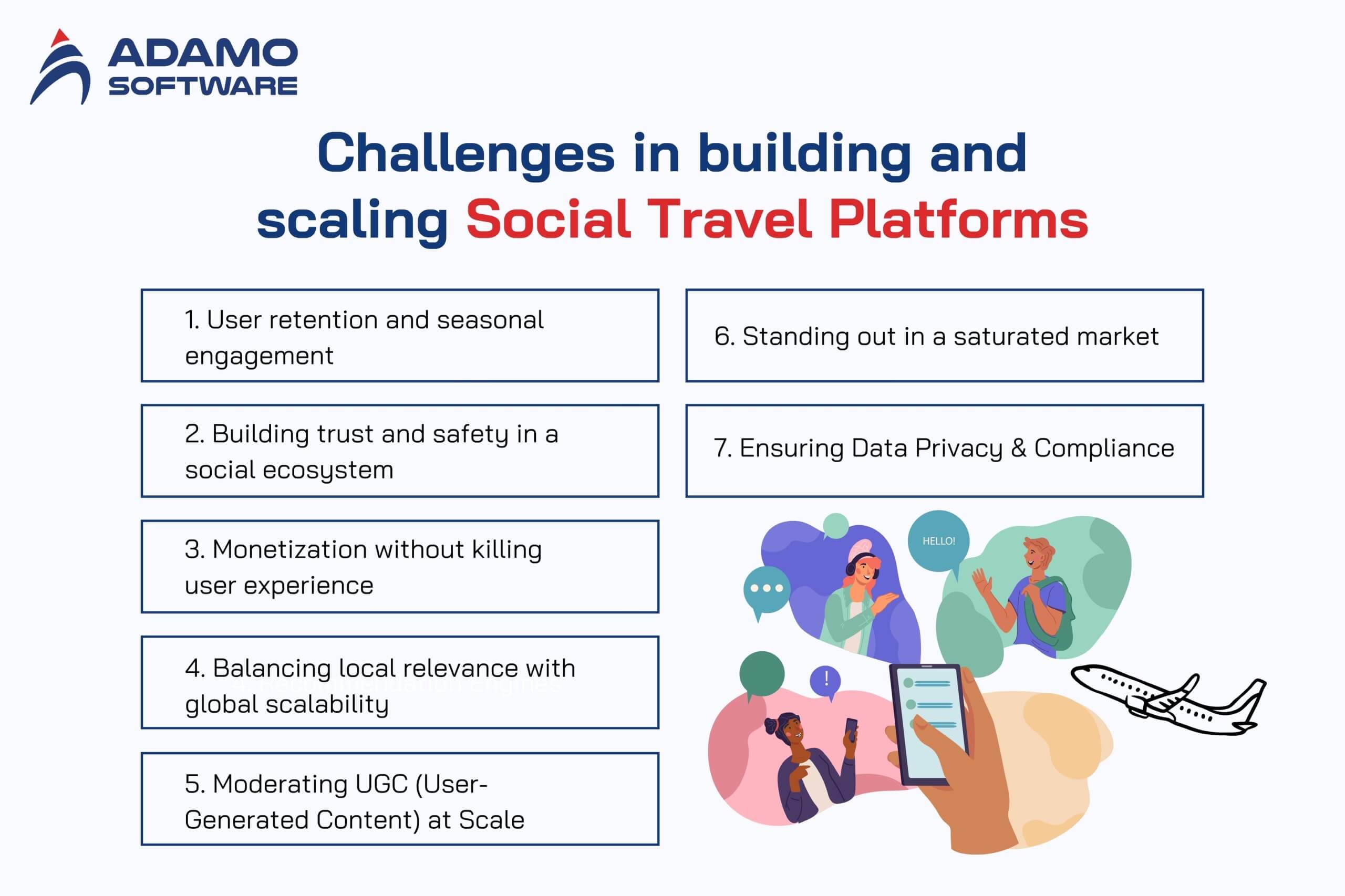Social Travel Apps: Benefits, challenges & future opportunities

Learn how social travel apps work, their key features & challenges, and how building community-led platforms unlocks new value for travel businesses.
In the digital age, travel behavior is changing rapidly. Users no longer seek information from traditional sources but actively explore, schedule, and make decisions based on real experiences from online communities. This is when travel social networking platforms become a place to connect, inspire, and share journeys between travel enthusiasts.
Developing a travel social networking platform brings much value to businesses in the travel app development industry. First of all, it helps build a community of loyal customers. At the same time, companies can exploit user data, personalize services, and expand new revenue streams, including advertising, strategic cooperation, and premium service packages.
In this article, we will learn what a social travel app is and why it is becoming a potential trend in the travel and tourism industry. Also, explore the core features needed to build effective products and some typical examples of today’s market.
I. What is a Social Travel App?
A social travel app is more than just a tool to plan trips—it’s a digital hub where travel meets connections. Instead of focusing only on flights and hotel bookings like traditional travel apps, social travel platforms are built around community, interaction, and shared experiences. They help travelers connect with others, share real-time updates, co-create itineraries, and turn solo adventures into collective journeys.
These apps empower travelers to:
- Connect with like-minded people about similar destinations.
- Share travel plans and travel tips and get real-time updates.
- Find travel buddies based on interests, location, or time.
- Join local meetups or group tours organized within the app
- Create a travel diary and share inspirational content for future travelers.
Key Components of a Social Travel App:
- User Profiles: Users can show their previous trips, dream destinations, interests, and travel styles.
- Smart Matching Algorithms: The system will suggest suitable companions based on common destinations, overlapping times, or similar interests.
- Collaborative Itineraries: Allow users to create and edit travel schedules on the application with friends or new acquaintances.
- Local Communities: Provides discussion groups by region or topic, helping users easily exchange and connect with the community at the destination.
- Real-Time Messaging: Support instant chat to plan together, ask for experiences, or arrange meetings.
Examples of Social Travel Apps:
- Travello brings together travelers from around the world by allowing them to join shared events and group experiences.
- GAFFL makes it easier for solo travelers to connect with compatible travel buddies for upcoming trips.
- Couchsurfing combines accommodation sharing with local cultural experiences.
- Travel Feed (TripAdvisor) integrates social features into its review system.
More and more people are not comfortable traveling alone these days. They want to connect, share experiences, and find like-minded travel companions. That’s where social travel apps come in.
These platforms don’t just help users choose a destination — they help them find people to share the journey with. For businesses, this is a huge opportunity to build meaningful, community-driven experiences where travel becomes a shared story, not just a solo adventure.
II. Why Social Travel Apps are gaining popularity
To understand the value of social travel app in the tourism industry, we first need to look back at how social media has changed the industry. Today, travelers want to search for information, interact, get instant updates, and connect with like-minded people. This has led to many new forms of tourism, where users can share photos, reviews of places, itineraries, and travel tips.
Traditional travel booking platforms (OTAs) have also grown with the support of social networks such as Instagram, Facebook, or Pinterest, where personal content dominates. However, these platforms do not specialize in tourism. Therefore, social media applications specifically for travelers have been born, focusing on building communities and deeper travel experiences.
III. Challenges in building and scaling Social Travel Platforms (Solutions included)
Social travel apps pave the way for people to explore the world – connecting, sharing, and experiencing together. However, building and scaling such an app is not easy. Behind a smooth platform are countless problems that need to be solved – from technical and user psychology to long-term development strategies.

1. User Retention and Seasonal Engagement
Travel behavior is often seasonal – peaking during the holidays and low in the remaining months. This causes visits and interactions in the app to fluctuate constantly. Therefore, maintaining long-term interactions when users are not actively traveling is an important challenge.
Solution: Don’t just be an app that serves users when they travel. Become a part of their daily lives with features such as seasonal destination suggestions, offline community meetings, or forums for sharing travel experiences.
2. Building Trust and Safety in a Social Ecosystem
Unlike a typical booking or tour app, a social travel platform has a community element – users interact with each other. This raises many concerns: fake accounts, misleading content, or harassment.
Solution: A strict account verification system, clear content moderation mechanisms, and transparent reporting tools are required. Factors such as verification badges and community reviews also help to increase trust.
3. Monetization Without Killing User Experience
Many apps are initially free to attract users, but they have difficulty switching to a monetization model because it is easy to lose the “essence” of the community.
Solution: Consider the freemium model, which provides basic features for free with advanced packages such as smart travel friend matching, offline itinerary saving, etc. In addition, cooperating with a network of travel partners to suggest suitable services is also a clever way.
4. Balancing Local Relevance with Global Scalability
To touch the emotions of users, the application must understand local culture. However, the system must ensure stable operation in many regions to expand the market.
Solution: Build a flexible content structure easily customized by region – from multilingual interfaces to separate communities by country/region.
5. Moderating UGC (User-Generated Content) at Scale
Social travel lives on user-generated content – from reviews and travel tips to shared itineraries. However, if it is poorly controlled, poor quality or offensive content will reduce the application’s reputation.
Solution: Combine AI pre-moderation with community input – allowing users to report inappropriate content. At the same time, there needs to be a clear set of standards and transparent communication about content policies.
6. Standing Out in a Saturated Market
When “big guys” like Airbnb, TripAdvisor, or Instagram also have similar features, what will you do to make users remember you? This can be a big challenge.
Solution: Focus on niche customer groups such as female solo travelers, digital nomads, or young people who love experiential travel. At the same time, build a brand identity around the community – not the product.
7. Ensuring Data Privacy and Compliance
Social platforms often collect sensitive information such as location, travel history, and user messages. This places strict requirements on security and compliance with laws such as GDPR and CCPA.
Solution: Store data securely, be transparent in your privacy policy, and allow users to manage their data.
Building a social travel app is more than just writing stable source code. It’s more about understanding how people interact in digital communities – from user psychology, to feeling safe when sharing, to cultural differences between regions.
The apps that can survive and thrive are often those that create a space that is trustworthy, fun, and adaptable to user needs.
IV. Top examples of Social Travel App to consider
1. TripAdvisor – A community of trusted reviews from real people, real events
TripAdvisor is a review database and the first touch point for millions of people when planning a trip. With many users and rich data, TripAdvisor creates a large network of shared experiences.
- Real reviews from users: From hotels and restaurants to local tours – everything is reviewed by people who have experienced it. This creates a sense of trust and community.
- Travel forum: Users can ask questions, share experiences, or seek advice on any topic – from visa applications and reasonable schedules to virtual living corners that not everyone knows.
- Real photo gallery: In addition to written reviews, TripAdvisor encourages users to share real photos, helping those planning a more realistic view of the destination.
2. Travel Mapper – Save your journey in a visual and personal way
For those who like to keep their journey with maps and images, Travel Mapper is a great tool. It subtly combines personal diaries and social sharing elements.
- Create a personal travel map: Users can mark places they have been to and add notes or images – creating a vivid itinerary map.
- Interactive features: Users can share their maps with relatives, friends, or the community – as a way to tell their travel story through images.
3. Travello – A real social network for travelers
Launched in 2014 in Australia, Travello positions itself as a specialized social network for those who love to travel – and that is reflected in the interface, features, and community they have built.
- Share diverse content: Users can post photos, videos, and travel statuses… similar to how they use Facebook or Instagram but focus on travel topics.
- Open interaction: You don’t need to follow to interact. You can like, comment, or share posts from any user, making spreading content easier.
- Integrated tour & activity booking: Travello stops at sharing and connects with services so users can find and book tours and experiences at the destination.
V. The future of social travel apps
As global travel trends change, community travel apps are no longer just a place to connect users. They are becoming smart ecosystems – places where people can meet, plan, and explore the world in a whole new way.
From artificial intelligence and virtual reality technology to blockchain and sustainable development solutions, all contribute to shaping the next generation of community-oriented travel platforms.

1. AI-powered personalization at scale
Today, travelers are accustomed to “tailored” experiences, like when using Netflix or Spotify. In that context, a travel app cannot stop by just providing general information.
AI can analyze search history, travel habits, and interaction behavior to suggest where to go, when to depart, or who is the most suitable travel companion.
According to McKinsey & Company, 71% of consumers expect personalization, and 76% are disappointed when they don’t get it. This can be seen as a clear wake-up call for social travel platforms that want to retain users.
Therefore, for tech companies, integrating AI into social travel apps is no longer a “nice-to-have” but a necessity to survive in a highly competitive market
2. AR and VR for Immersive Exploration
No longer limited to photos or 2D maps, AR/VR technology is opening up a completely different way of experiencing destinations:
- Take a virtual reality tour with a guide via AR.
- Explore the city with real-life navigation games.
- Preview your destination in VR before deciding to book a ticket.
According to Statista, the AR/VR market in the tourism sector could reach $304 billion by 2030.
“Virtual reality is narrowing the gap between digital experiences and real-life travel decisions.”
— Carla Bond, travel innovation expert, Phocuswright
3. Decentralized Communities with Web3 + Blockchain
For community-based travel platforms, trust is the core element. Blockchain can:
- Verify user identities and transactions, helping reduce fraud.
- Integrate cryptocurrency payments (like Atlas and Travala have done)
- Token reward system incentivizes users to contribute high quality reviews and active participation.
- This not only creates a transparent and fair ecosystem but also long-term sustainability.
4. Integrate sustainable and ethical travel
Environmental awareness is directly influencing traveler choices. According to Booking.com, 76% of global travelers want to travel more sustainably.
Future travel apps will integrate eco-friendly activity suggestions, support local businesses, and offer carbon offset options into your itinerary.
5. Greater Inclusion and Accessibility
Accessibility is becoming a core design principle when building community tourism products:
- Solo female travel apps like Tourlina are popular for their safety and connection based on preferences.
- AI translation and multilingual support help break down language barriers.
- Planning support for people with disabilities will be a major competitive advantage.
6. Real-time, always-on community engagement
The future of social travel apps will be “digital lounges” – where users can:
- View a map of nearby users for easy connection.
- Co-plan in real-time and organize impromptu meetups.
- Interact via stories, votes, and tag locations on the news feed.
VI. How Adamo Software supports Social Travel App Development

With years of experience, Adamo Software has worked with more than 150 global businesses and delivered 200+ successful travel and hospitality software development projects — including social travel apps, travel booking platforms, tour management systems, and OTA solutions.
We offer end-to-end development services, from strategic consulting and user-friendly UI/UX design to building key features like itinerary sharing and interactive maps. But we don’t just build apps — we build long-term partnerships. Our team enables features that foster community interaction, content sharing, and social discovery — turning your app into a space where travelers connect, collaborate, and keep coming back.
Contact us today to turn your travel app idea into a thriving platform.
FAQs
1. What is a travel social media platform and why should you build one?
A travel social media platform is an online space where users – those who love to travel – can share their journeys, post photos/videos, write reviews, and connect with a community of like-minded people. It is both a living travel guide and a place for exchange and inspiration between travel enthusiasts.
2. Why develop a social media platform specifically for travelers?
Building a travel-focused social media platform helps you create a niche community – where people can find new ideas, exchange schedules, and explore unique destinations from real-life experiences. It is also an opportunity to expand your business model through advertising, brand collaboration, paid features, or providing exclusive deals.
3. What are the must-have features of a social travel platform?
To attract and retain users, your platform should incorporate the following features:
- User-friendly interface.
- Real-time travel itinerary and information updates.
- Allows you to create and share personal itineraries.
- Community reviews and comments.
- Fast photo and video uploads.
- Social interaction features such as following, liking, and commenting.
- Exclusive travel deals or promotions.
4. Which travel apps have the best features for community engagement?
Here are three travel apps with strong community-engagement features — useful case studies if you’re evaluating travel tech or considering building features via an outsourcing development service.
| App | Community Focus | Key Feature |
|---|---|---|
| Couchsurfing | Host/traveller connections + local events | Meet-ups, local hosts, shared adventures |
| Explurger | Photo-/video-sharing travel feed | Visual community feed, check-ins |
| Waze | Crowd-sourced live updates (traffic/travel) | Real-time user reports/alerts |
5. Are there travel apps focused on social discovery and sharing?
Yes. There are travel apps focused on social discovery and sharing. Here are three notable examples:
- Jetzy: This app connects users with like-minded travellers and enables sharing of travel-adventure posts in a social feed.
- Turistly: It is described as a modern social-discovery travel app where users share photos, discover new places, join events, and plan activities.
- Explurger: It is a travel social-media-style app: users share real-time check-ins, photos/videos, create digital travelogues and discover new places via community content.











